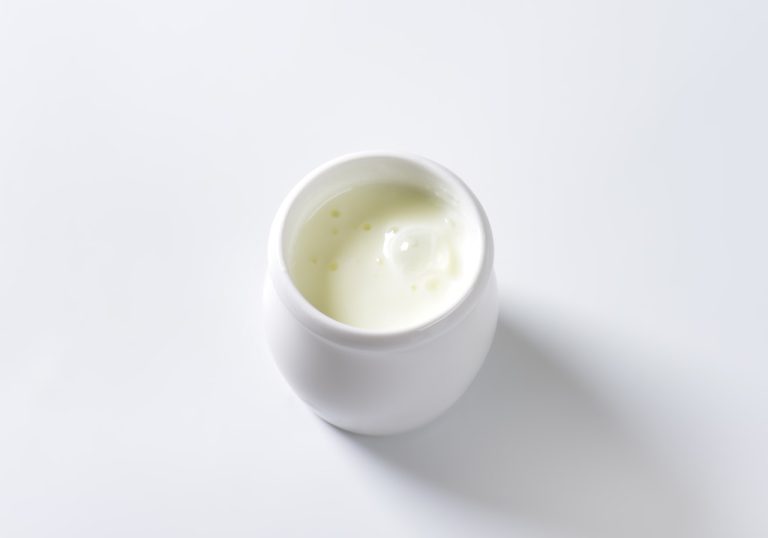The tasty kefir has been said to have health-promoting properties for centuries. We’ll tell you what kefir is made of and why the drink is good for your body.

Kefir – what is it?
Kefir is a slightly carbonated, thick sour milk drink. It is created by fermentation processes of milk with kefir fungi, in which yeasts are also involved in addition to lactic acid bacteria. Kefir has its origins in the Caucasus region. Here people have sworn by its healthy effects for centuries and also call it the “drink of the centenarians”. Due to the fermentation process, kefir is largely lactose-free.
Traditionally, kefir was made from mare’s milk. Today, cow’s milk is mostly used for this. But a vegan kefir drink can also be made from plant milk. Kefir made from milk tastes slightly sour and is comparable to buttermilk. Depending on the manufacturing process, kefir has carbonic acid and a low alcohol content.
The kefir mushroom
To make kefir, a so-called kefir fungus is added to the milk. This is also known as “kefir grain”, “Tibetan mushroom” or “Caucasian milk kefir” and has the appearance of a small, pure white cauliflower.
A kefir mushroom can be dried for storage or frozen and used as needed. The mushroom doubles in size in about two weeks at room temperature. If stored properly, you can live off a single kefir mushroom for a lifetime.
To make kefir, the kefir fungus is left in the milk for at least 24 hours, which starts the fermentation process. In this natural process, important substances from the milk are increased and poorly tolerated substances and bacteria are broken down.
Microorganisms of the kefir fungus decompose, among other things, the milk sugar (lactose) in the pure milk, harmful bacteria such as listeria and the poorly digestible casein. At the same time, they form small amounts of carbonic acid, lactic acid and alcohol. So you can safely consume kefir drinks if you are lactose intolerant. The kefir fungus also contains numerous important nutrients and minerals, which it transfers to the milk during fermentation and multiplies in it. These include:
calcium
iron
folic acid
iodine
Niacon
polysaccharides
Vitamins A, B1, B2, B12, C and D
What makes kefir so healthy
Kefir mushrooms also contain numerous health-promoting microorganisms such as bacteria, bacilli, yeast and streptococci, summarized under the term “probiotics”. These stabilize the intestinal flora and ensure that undesirable, pathogenic microorganisms are combated. With regular consumption of kefir, the healthy microorganisms sustainably strengthen the immune system. So kefir can help with a variety of diseases and ailments, including:
Intestinal infections and bacterial imbalances in the gut caused by antibiotics
chronic fatigue
sleep disturbances and nervousness
allergies
Diseases of the liver, gallbladder and heart
stomach ulcers
problems with blood pressure
Various inflammations
osteoporosis
Furthermore, the kefir fungus is said to slow down the aging processes of the body cells and to increase memory performance.
In addition to the traditional milk kefir, there are also “water kefir” and the now well-known tea fungus “Kombucha”. They all have in common that they are a mixture of substances made up of bacteria, vitamins and yeasts.

Kefir – choosing the right milk
You can either buy kefir as a ready-made drink or make it yourself. With both variants, however, you should make sure that you get the milk base in organic quality. Scientific studies have found that organic milk contains around 50 percent more important omega-3 fatty acids than comparable milk from discounters. This is because cows from organic farms have a richer and fresher choice of feed, which directly affects the quality of the milk. The cell-protecting omega-3 fatty acids from the organic milk are processed and increased by the kefir fungus, which has a positive effect on the end product. At the same time, by buying organic milk, you are supporting more species-appropriate husbandry of the dairy cows.
On the other hand, industrially produced kefir is sold under the name “Kefir, mild”, in which a specific composition of bacteria and yeasts is used instead of the actual kefir fungus. This kefir drink contains little or no alcohol, but – unlike the traditionally produced kefir – is not lactose-free and therefore not suitable for people with lactose intolerance.
A kefir mushroom can also be cultivated vegan, for example in coconut milk, almond milk, soy milk or fruit juice. Either way, it’s healthy and delicious. However, in contrast to milk kefir, a plant-based kefir drink has fewer health-promoting nutrients such as lactic acid bacteria.

